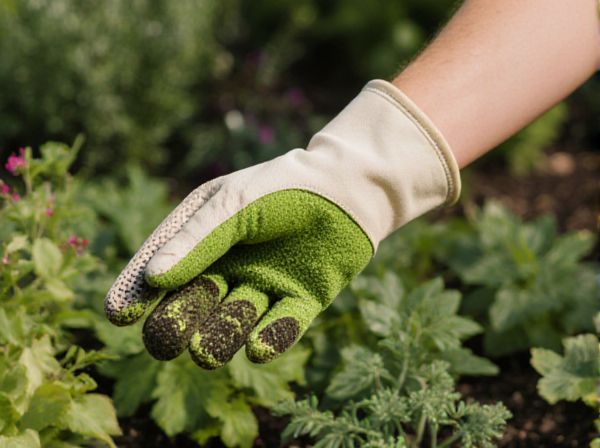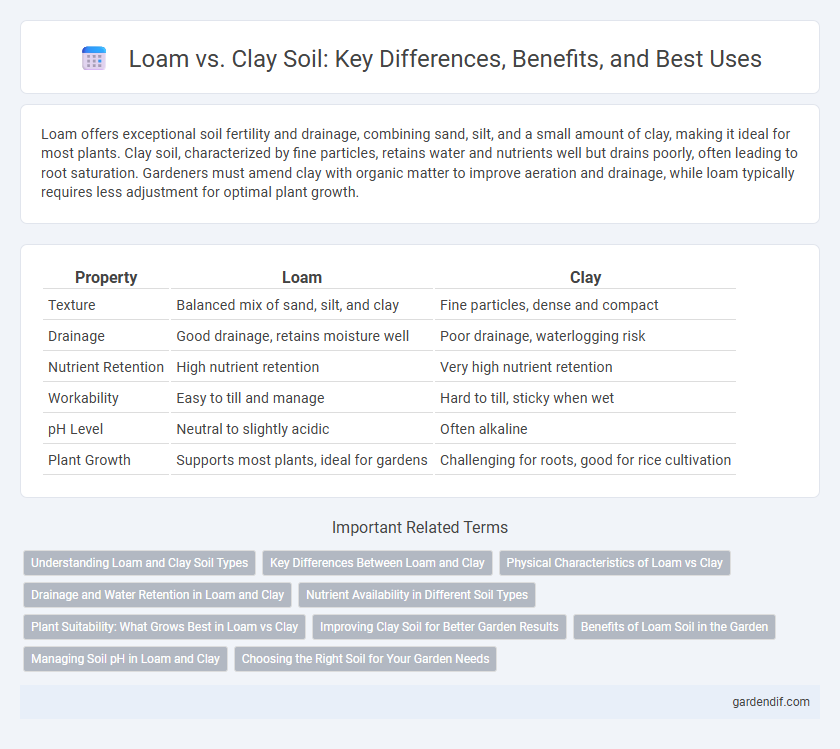
Loam vs Clay Illustration
Loam offers exceptional soil fertility and drainage, combining sand, silt, and a small amount of clay, making it ideal for most plants. Clay soil, characterized by fine particles, retains water and nutrients well but drains poorly, often leading to root saturation. Gardeners must amend clay with organic matter to improve aeration and drainage, while loam typically requires less adjustment for optimal plant growth.
Table of Comparison
| Property | Loam | Clay |
|---|---|---|
| Texture | Balanced mix of sand, silt, and clay | Fine particles, dense and compact |
| Drainage | Good drainage, retains moisture well | Poor drainage, waterlogging risk |
| Nutrient Retention | High nutrient retention | Very high nutrient retention |
| Workability | Easy to till and manage | Hard to till, sticky when wet |
| pH Level | Neutral to slightly acidic | Often alkaline |
| Plant Growth | Supports most plants, ideal for gardens | Challenging for roots, good for rice cultivation |
Understanding Loam and Clay Soil Types
Loam soil is a balanced mixture of sand, silt, and clay particles, offering excellent drainage and nutrient retention that supports healthy plant growth. Clay soil consists predominantly of fine particles, resulting in poor drainage and a dense texture that retains water and nutrients but can restrict root development. Understanding these properties helps gardeners and farmers choose the right soil type for specific crops or amendments to improve soil structure and fertility.
Key Differences Between Loam and Clay
Loam and clay differ primarily in texture and drainage properties; loam consists of balanced proportions of sand, silt, and clay, resulting in excellent aeration and water retention, while clay is dominated by fine particles that compact tightly and hold water excessively. Loam offers superior fertility and root penetration, making it ideal for most crops, whereas clay's dense structure can impede root growth and cause waterlogging. Soil management practices vary as loam requires less amendment, but clay often needs organic matter or sand to improve structure and drainage.
Physical Characteristics of Loam vs Clay
Loam soil has a balanced mixture of sand, silt, and clay, giving it a crumbly texture that enhances aeration and drainage, making it ideal for plant growth. Clay soil consists primarily of fine particles that bind tightly, resulting in a dense, sticky texture that retains water and reduces permeability. The physical characteristics of loam promote root penetration and nutrient availability, while clay's compact structure can cause waterlogging and slow root development.
Drainage and Water Retention in Loam and Clay
Loam soil offers excellent drainage due to its balanced mixture of sand, silt, and clay, allowing water to flow through easily while retaining sufficient moisture for plant roots. Clay soil, characterized by its fine particles, has poor drainage which leads to water retention and potential waterlogging, making it less ideal for plants requiring well-aerated soil. The superior water retention of clay can cause root suffocation, whereas loam promotes healthy root growth by maintaining optimal moisture levels and air circulation.
Nutrient Availability in Different Soil Types
Loam soil offers optimal nutrient availability due to its balanced mixture of sand, silt, and clay, which enhances aeration and water retention, promoting nutrient uptake by plants. Clay soil, while rich in nutrients because of its fine particles and high cation exchange capacity, often restricts root growth and limits oxygen flow, reducing nutrient availability. The nutrient availability in loam supports healthier plant development compared to the denser, moisture-retentive clay that can cause nutrient lock-up in soil profiles.
Plant Suitability: What Grows Best in Loam vs Clay
Loam soil, composed of balanced sand, silt, and clay, offers excellent drainage and nutrient retention, making it ideal for a wide variety of plants including vegetables, flowers, and fruit trees. Clay soil retains water and nutrients effectively but can become compacted, favoring plants such as roses, daylilies, and certain native grasses that tolerate slower drainage. Understanding the distinct properties of loam and clay helps optimize plant growth by matching species with soil conditions.
Improving Clay Soil for Better Garden Results
Improving clay soil involves incorporating organic matter such as compost or aged manure to enhance drainage and aeration, which prevents waterlogging and root rot. Adding coarse sand or gypsum can break up dense clay particles, promoting better soil structure and root penetration. Regularly mulching and avoiding compaction by minimizing foot traffic also help maintain soil health for optimal plant growth.
Benefits of Loam Soil in the Garden
Loam soil offers an ideal balance of sand, silt, and clay, providing excellent drainage and nutrient retention essential for healthy plant growth. Its porous structure enhances root aeration while maintaining adequate moisture, supporting a diverse range of garden plants. Compared to clay, loam's superior texture reduces compaction and promotes robust microbial activity, improving soil fertility and overall garden productivity.
Managing Soil pH in Loam and Clay
Managing soil pH in loam requires balancing its naturally neutral to slightly acidic composition by amending with lime to raise pH or sulfur to lower pH, promoting optimal nutrient availability. Clay soil, with its dense structure and tendency to retain acidity, often necessitates frequent pH adjustments and improved drainage to prevent nutrient lock-up and enhance root growth. Understanding the distinct buffering capacities of loam and clay enables precise soil pH management, improving crop yields and soil health.
Choosing the Right Soil for Your Garden Needs
Loam soil, with its balanced mixture of sand, silt, and clay, offers excellent drainage and nutrient retention, making it ideal for most garden plants. Clay soil tends to retain water and nutrients but can become compacted, limiting root growth and aeration unless properly amended with organic matter. Selecting the right soil depends on your garden's specific water drainage requirements and the types of plants you intend to grow.
Loam vs Clay Infographic

 gardendif.com
gardendif.com